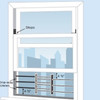Description
NYC HOW TO INSTALL WINDOW GUARD
In buildings with three or more apartments, building owners must install New York City Health Department-approved window guards if a child age 10 years or younger lives in the apartment, or if a tenant or occupant requests window guards for any reason. All window types, including sliding windows with screens, should have window guards or limiting devices. Window screens are not a substitute for window guards Window guards or limiting devices must:
• Be installed in all windows of the apartment, except for windows leading to fire escapes or used for emergency escapes, or in windows where air conditioner units are permanently and safely installed.
• Be secured and permanently installed.
• Prevent windows from opening more than 4 1/2 inches in any direction. There should never be more than 4 1/2 inches of open unguarded space. Use a measurement tool to check.
• Be able to withstand 150 pounds of weight.
• Have a New York City Health Department-approval number
How to Install Window Guards Under Local Law 57
Local Law 57 mandates the installation of window guards to ensure the safety of residents, particularly children. Proper installation is crucial for the effectiveness of these safety devices. Here’s a step-by-step guide on how to install window guards in compliance with Local Law 57:
1. Gather Necessary Tools and Materials:
- Approved window guards that meet the specifications of Local Law 57.
- Measuring tape.
- Pencil or marker.
- Drill with appropriate drill bits.
- Screws or other fasteners provided with the window guards.
- Screwdriver.
- Level.
- Anchors (if required for certain wall materials).
2. Measure the Window:
- Measure the width and height of the window to ensure you have the correct size of window guard.
- Verify that the window guard you have is compatible with the window’s dimensions.
3. Mark the Installation Points:
- Position the window guard in the window frame to determine where the mounting brackets will be placed.
- Use a pencil or marker to mark the screw hole locations on the window frame or wall.
4. Drill Pilot Holes:
- Drill pilot holes at the marked locations. This step helps prevent the wood from splitting and makes it easier to insert the screws.
- If you are drilling into a concrete or brick surface, use appropriate drill bits and insert anchors into the holes.
5. Install the Mounting Brackets:
- Attach the mounting brackets to the window frame or wall using the screws provided.
- Ensure the brackets are securely fastened and aligned properly.
6. Attach the Window Guard:
- Place the window guard into the mounted brackets.
- Use the provided screws to secure the window guard to the brackets.
- Make sure the guard is tightly secured and does not wobble or move.
7. Check the Installation:
- Use a level to ensure the window guard is installed straight and properly aligned.
- Test the stability of the window guard by applying pressure to ensure it is securely installed.
8. Final Inspection and Maintenance:
- Conduct a final inspection to verify that all screws and fasteners are tight and the window guard is securely in place.
- Regularly inspect the window guards to ensure they remain in good condition and perform necessary maintenance as needed.
Additional Tips:
- Double-Check Compliance: Make sure the window guards you are using comply with Local Law 57 specifications regarding material, bar spacing, and strength.
- Tenant Communication: Inform tenants about the installation process and ensure they understand the importance of not tampering with the window guards.
- Professional Installation: If you are unsure about installing window guards yourself, consider hiring a professional to ensure they are installed correctly and safely.
By following these steps, property owners can ensure they are in compliance with Local Law 57 and contribute to a safer living environment for all residents. Proper installation and regular maintenance of window guards are essential for preventing accidents and ensuring the safety of young children.
DISCLAIMER DISCLAIMER ON LEGAL CODES DISCLAIMER ON SIGN USE GENERAL INFORMATION DISCLAIMER
We are a small, family-owned and family-operated Brooklyn-based business. We are not a City of New York store, nor are our website, products, or services affiliated with the City of New York or any agency of the City of New York. Neither we, nor our business, websites, products, services, or any hyperlinks from our website are sponsored by, approved by, affiliated with, endorsed by, or connected to the City of New York or any agency of the City of New York, including but not limited to HPD, DOB, DOT, DSNY, FDNY, or any federal entity, directly or by implication.
The codes, regulations, and requirements referenced on our website may not represent the most recent or updated versions. State, federal, or local regulatory agencies may have more current or accurate information. We make no warranties or guarantees about the accuracy, completeness, or adequacy of the information provided on this site or linked from it. Customers should verify all information by reviewing the official sources directly.
The requirements for sign content depend on intended use and applicable laws. The buyer is solely responsible for determining the appropriate content for a sign or package of signs. We make no warranty or representation regarding the suitability of any sign for a specific application. It is the customer’s responsibility to ensure that the signs ordered are in compliance with all applicable state, federal, local, and municipal laws. Customers are encouraged to carefully review our Terms and Conditions prior to purchase.
All content on this site is provided for informational purposes only and does not constitute legal advice, professional advice, or a definitive statement of law. For guidance on specific requirements, customers should consult the laws and regulations referenced, as well as any rules applicable in their jurisdiction. You may wish to consult with an attorney or qualified professional to ensure compliance with all applicable legal obligations.




















